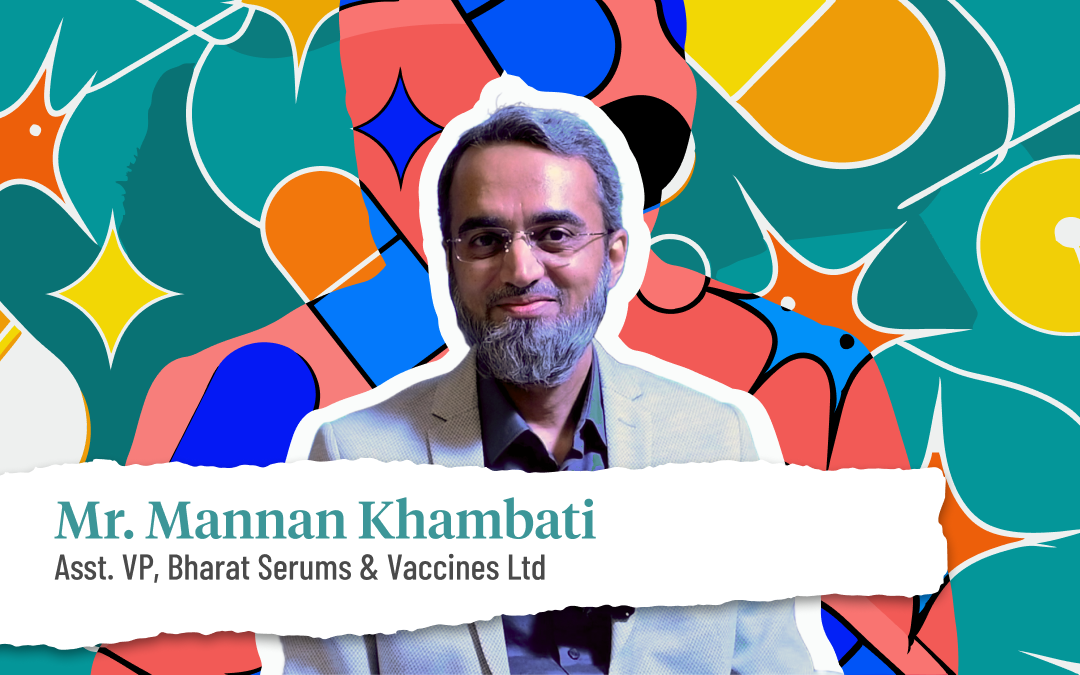QnA
Interview | August 9, 2025
Dr. Shuvankar Ballav is the Manager and Lead of Regulatory Affairs (Biosimilars) at Advanced Biotech Lab (ABL), Ipca Laboratories Ltd., Mumbai, where he leads a dynamic team focused on advancing global compliance, regulatory strategy, and dossier excellence. With expertise spanning US FDA, EMA, MHRA, Health Canada, and RoW markets, he oversees the entire regulatory lifecycle for biosimilar products—from early clone development to final commercial release—providing critical inputs on R&D, manufacturing, and CMC documentation. His role encompasses reviewing technical and GMP manufacturing records, compiling product characterization data, preparing and submitting global regulatory dossiers, and crafting precise responses to agency queries.
Pharma Now: Dr. Ballav, welcome to Pharma Now. It’s an honor to host you here. I was just going through your profile, and I think your journey is amazing. The objective of this podcast is to inspire upcoming generations to walk in the footsteps of leaders like you.
You're already a distinguished leader in the industry, playing a significant role in regulatory affairs at a large pharmaceutical company. We wanted to understand how you started your journey, from Kolkata to becoming the Head of Regulatory Affairs at IPCA Laboratories. Did you always want to be a pharmacist as a child, or was your path something different?
Dr. Ballav: Certainly. Actually, I’d say I’m just a simple, average person. As a child, I was studious, and like most kids, I wanted to become a doctor. Biology was my core interest. I always wanted to invest more in becoming a doctor, but somehow, after my 12th, that didn’t happen. I got selected for engineering, and it became a question of, "Now what?"
Before that, I want to give credit to my mom. She dreamed of me becoming a scientist. She would show me television programs about biotechnology. This was around 2006 or 2007. At that time, biotechnology wasn’t that prominent, especially in West Bengal, but there were research-focused programs. She inspired me.
So I moved to Bangalore for my undergraduate studies in biotechnology, along with chemistry and zoology. Fortunately, or unfortunately, things worked out well. In my first semester itself, I became the college topper. I remember a message from my dad that day: “We’re happy with your success, but we want you to be a doctorate.” It was his dream that I should get a PhD.
I completed my graduation in biotechnology and went to Vellore Institute of Technology for my dissertation. At that point, I was focused on becoming a scientist. But I also saw my seniors entering the industry, and like any student, I thought, "Okay, they’re earning. I need to earn too." So I got a job even before completing my degree because of my research exposure at the Indian Institute of Science.
I joined a company as a fresher with an MSc, but the role wasn’t fulfilling my scientific curiosity. I wanted to work independently and complete projects on my own. That’s what pushed me toward a PhD. I moved to Goa for my PhD in marine biotechnology and was selected as an INSPIRE fellow by the Ministry of Science and Technology.
That PhD journey lasted four and a half years, full of learning, research, planning my own projects, dealing with ups and downs, and even gaining teaching experience. I attended conferences, including ones like this, where I get to speak, which helped shape me.
After completing my PhD, I was selected as a National Postdoctoral Fellow in infection biology, working on malaria. Initially, I was enthusiastic and working on a project funded by the NIH (National Institutes of Health, US). But soon, I started asking myself, “What next?” I wanted to become a scientist, but I saw many others like me trying to establish themselves. I wanted something more secure, a proper job and recognition.
So after two years, I resigned, even though I was on the highest-paid postdoc fellowship in the country. My mentor was supportive and didn’t want me to leave, but I decided it was time. I came home and took a break for one or one-and-a-half months, a period of deep introspection.
Then I started applying for jobs. The challenge was that once you become a PhD and postdoc, you’re considered overqualified for many industry roles. And if your PhD isn’t aligned with industry needs, companies hesitate. But I believe that if you’re hardworking, someone will give you a chance.
I was lucky to get a mentor, Dr. Anita Krishnan. Today, she heads Biocon Global R&D. At that time, she was at Lupin and hired me as a Senior Executive in their CMC Biotech division. That’s how my industry journey started. I spent two years at Lupin, learning about CMC, industry processes, product development, and documentation.
Then I received an offer from Biocon for their Global Regulatory Affairs department. Biocon is a massive company, and working there gave me exposure to multiple global submissions and a highly professional environment. That’s where I was groomed into a complete regulatory professional. It gave me the confidence to handle entire projects.
After Biocon, I had a short stint at Aurobindo Curetic Biologics, and then I moved to IPCA. IPCA is a growing company. They were starting their biosimilar division from scratch, with their own set of challenges. Here, I got the chance to establish the regulatory affairs department from the ground up.
This department is like my baby. I nurture it every day, bringing in new ideas, aligning with regulatory guidelines, and contributing my inputs. It’s very close to my heart. Since I’ve been here from the beginning, I also get to be the decision-maker for my team.
I work under the excellent supervision of Dr. Sanjiv Gupta, who heads the biosimilar unit at IPCA. He’s an encouraging and positive leader and has entrusted me with this responsibility. So yes, I currently serve as Head of Regulatory Affairs for IPCA Biosimilars.
It’s been a fantastic journey. There are challenges, but we face them as a team. There’s no blame game, only positive thinking. I start my day believing there are no problems, only solutions. Whenever I face a regulatory challenge, my mindset is always, “This has to be solved.” I read the literature, follow guidelines, review product development, and continue progressing in my role.
Pharma Now: Before we move forward, there was a significant transition in your career, from CMC to Regulatory Affairs. What was your mindset during that shift?
Dr. Ballav: That’s a great question. Honestly, the transition wasn’t easy. When I joined Biocon as an Assistant Manager, there were certain expectations from me. I had a solid foundation in product quality and CMC, which definitely helped in preparing regulatory documents. However, I didn’t fully grasp the regulatory guidelines or how to structure a submission. That part was new to me.
The initial days were genuinely tough. I was fortunate to have supportive and encouraging managers who believed in me. They saw potential and gave me the space to grow. I didn’t want to disappoint them, and that kept me going. Mistakes did happen, no doubt about that, but I always faced them head-on. I believe in discussing issues openly, not hiding them, because every challenge has a solution if you're willing to learn.
So yes, the first three to four months were challenging. As you rightly said, a transition like that doesn’t happen overnight. You can dream of it and manifest it, but it takes time, dedication, and a lot of hard work.
Pharma Now: Correct. So, Shuvankar, I wanted to take a step back and go into something like Regulatory 101. For many in our audience, the term “regulatory” sounds like something very complex or intimidating. And every time a company receives a warning letter, the share price drops by 5–10%. People don’t really understand what that means. Could you help break down what regulatory compliance is all about?
Dr. Ballav: That’s a good place to start, and maybe I’ll actually begin with the concept of a warning letter. A warning letter is issued when a company is not in compliance with regulatory expectations, usually, those related to good manufacturing practices (GMP).
Before a warning letter, there are observations, which are communicated during inspections. But when those observations are serious, classified as major, and require systemic corrections, that’s when a warning letter is issued. It comes with a timeline to respond, correct the issues, and demonstrate that you've implemented solutions. Once that’s done, the letter can be lifted.
Now, people panic when they hear about things like a USFDA Form 483. But honestly, I don't think there’s any major Indian pharma company that hasn’t received a 483. The important thing is how you respond to it. A 483 should be taken as an opportunity to improve systems. After all, we’re not doing this just to check a box; we’re doing it for the patients, for the people, and for the lives we want to serve.
So yes, receiving a 483 or even a warning letter isn’t something to be proud of, but it’s also not the end of the world. It’s a signal to take action, fast. Don’t waste time in endless meetings. Act on the feedback.
Now, to avoid such issues in the first place, your Regulatory Affairs and Quality Assurance teams must work closely together. QA is responsible for setting and maintaining systems; Regulatory Affairs brings in the guidelines and expectations of global authorities. When both departments collaborate and do regular gap assessments, the risks go down dramatically.
And gap assessment is critical; many times, teams assume that whatever they’re doing is already the best. But you need constant evaluation. Create a matrix: identify the gap, track it, and close it. That’s how you stay ahead.
Coming to your point about share prices, when a company gets a warning letter, it often leads to halted production because regulatory bodies may no longer accept products from that site. That’s why the markets react. But again, with the right mindset, even a warning letter can be a turning point.
In fact, I often say that Regulatory Affairs professionals are like the Avengers; we bring all the stakeholders together. When something is achieved in Regulatory, it’s not an individual win. It’s a win for the entire organization. Because in the end, Regulatory represents the company to the outside world, and what we achieve, we achieve for everyone.
Pharma Now: Correct. So, going back to the topic of warning letters, the USFDA issues Form 483s and warning letters. What about other regulatory bodies?
Dr. Ballav: Other agencies issue observations too, categorized as major or minor. For example, when the EMA (European Medicines Agency) audits a facility, they provide major and minor observations. If you’re applying for EMA product approval, they’ll audit your site. Once you clear that audit, your facility is considered EMA-GMP qualified.
If you don’t clear it, they’ll issue observations with a timeline for resolution. You’re expected to respond and implement corrections within that timeline.
Similarly, CDSCO (Central Drugs Standard Control Organization) also gives observations. Unless those are closed, you cannot manufacture the product in question. Observations are issued to the facility, but most of the time, they’re product-specific, because applications are product-specific. So, if you have an issue with one product, it doesn’t necessarily stop your entire production, but the agency may lose confidence in your site overall. And that’s serious; if an agency says, “We’ve lost confidence in you,” that’s a harsh message and something you never want to hear.
So when you receive an observation, it’s critical to take action and resolve it. And I’ve personally experienced the satisfaction that comes when you successfully close out observations; it gives you immense happiness.
But what shouldn’t happen is endless discussions. “We could do this,” or “we could have done that.” Instead, come up with a clear action plan and execute it.
Also, I’ve faced EMA auditors myself. They’ve often remarked that, in India, we’re too obedient; we tend to agree with everything auditors say, instead of defending our systems. We need to have more confidence. If your system is robust and based on good science, you should be able to justify it.
When auditors raise an observation, respond with scientific rationale and logic. That’s how they will understand your perspective. If you just say “yes” to everything without explanation, you accept it, and it becomes your burden to correct. Confidence and communication are key.
Pharma Now: What are some of the most important regulatory agencies across the globe?
Dr. Ballav: The two most critical agencies are the EMA (European Medicines Agency) and the USFDA (United States Food and Drug Administration).
If your facility receives EMA GMP certification, it’s a significant advantage. Once EMA approval is granted, it often covers several other agencies as well. For example, the MHRA (the UK’s regulatory agency) follows EMA guidelines, so clearance becomes easier. Additionally, many ROW (Rest of World) countries, such as Vietnam, Thailand, Singapore, and South Africa, accept or recognize EMA or USFDA approvals. So, if you’re approved by a major regulator, semi-regulated and smaller markets are usually easier to access.
However, India is a bit different. Even if you have EMA or USFDA GMP certification, the CDSCO (Central Drugs Standard Control Organization) will still audit your facility independently. They do not rely on foreign approvals because they operate under their own jurisdiction, and I actually support that approach.
In India, each state has its own zonal office that conducts inspections. These zonal offices visit facilities, conduct audits, and ensure compliance with national standards. It’s a robust system that ensures local accountability, regardless of global approvals.
Pharma Now: Right. As you rightly said, the Regulatory Affairs team is basically like the Avengers; they call in everyone when the time comes. So, how difficult is it for your team to coordinate with each department, and at what stage do you start getting involved?
Dr. Ballav: Regulatory professionals usually work directly with department heads or leaders. Is it difficult? Well, all the fingers on your hand are not equal, right? So yes, it can be challenging. But as a regulatory person, you need to have a calm and composed mindset, one that understands others' challenges and knows how to get things done.
When you're speaking to a department leader, you can't just impose deadlines or requirements. You must understand their limitations too. Have a dialogue. Bring everyone to the same table, discuss the plan, and execute together. Being in regulatory is like leading a project, but without calling yourself a leader.
In fact, you don’t get a throne, but you play the role of a leader. You bring everyone together, and they listen because they understand the importance of your role. All their data goes through you. So, first and foremost, you must earn their trust. Once you gain their trust, they'll share the data with you.
Meeting timelines requires breaking large goals into smaller, manageable plans. Create a structured matrix to track every part, what’s planned, what’s delayed, and what risks that delay pose. For example, a single submission has multiple sections. Have a Target Completion Date (TCD) for each section. Maintain gentle follow-ups, and if someone faces a challenge, talk to them, understand, and see how you can help. Involve the project management team where needed.
Cross-functional work spans everything, from clone development to packaging and raw material procurement. Regulatory Affairs heavily depends on Quality Assurance and Project Management. Of course, the structure may vary from company to company. Sometimes, regulatory identifies bottlenecks and flags them to the project team for resolution. That’s how collaboration helps.
Pharma Now: Wonderful. Now, we all know about regulatory compliance in pharma companies, but how different is it when it comes to biosimilars and biopharma?
Dr. Ballav: When you’re talking about biopharma or biosimilars, the core difference lies in the molecule itself, small molecule versus large molecule. Biosimilars are large protein molecules, so naturally, they’re more complex.
The work is far more extensive. There’s a huge amount of R&D involved. Starting from clone development, you're dealing with biological systems, not machines. These systems have their own inherent behavior; you need to have strict control to ensure they behave consistently over time.
There’s upstream processing and downstream processing, both of which work on biological systems. In contrast, small molecule pharma is relatively straightforward. Even the regulatory dossier for pharma is much smaller. Just to give a rough idea: a typical pharma dossier might be 500 to 600 pages, including Modules 1 to 5. For biosimilars, it could go up to 6,000 to 7,000 pages, including clinical reports. So yes, it’s almost 10 times more in terms of scope. I’m not undermining pharma, but that’s just a fact.
Pharma Now: So, regulators like the USFDA have recently started internal circulation of AI-based tools. How is AI impacting the work of regulatory professionals?
Dr. Ballav: AI isn’t impacting regulators directly; it’s actually helping us. It’s still in its early stages, but we’re actively exploring how best to use it. In regulatory affairs, speed is everything. We often need quick summaries or immediate insights, and that’s where AI helps, especially in data processing.
However, validation is key. AI pulls from its available sources, which may not always be comprehensive. If some data is in non-digitized formats, like hard copies, AI will miss it. So whatever AI gives us must be validated against official documents. AI is also being explored in process development, particularly with extrapolation and design space predictions. This can reduce the number of experiments we need to run, saving both time and cost.
Some teams are also using AI for writing dossiers, responding to regulatory queries, and even for regulatory intelligence. For example, reading 150 queries manually takes time. But an AI tool can provide structured templates, helping speed up our responses.
Still, domain expertise is non-negotiable. You must know the science and the regulations inside out, because only then can you spot if AI has missed something critical. It's a powerful assistant, not a replacement.
Pharma Now: With current AI implementation, hallucination is a real challenge. I believe it’s critical how the model is designed and developed.
Dr. Ballav: Absolutely. That’s where model validation becomes so important. If you refer to the USFDA’s approach to AI, they emphasize early engagement. They’re not saying just go ahead and implement, what they want is a proof of concept.
You need to discuss your AI concept with them beforehand, show how it works, and get feedback before full-scale implementation. The agency doesn’t want to be told after the fact, “We’ve already done it and can’t change it.” So, run your pilot batches, demonstrate the model’s reliability, and ensure it’s valid in the regulatory context before going ahead. That’s the right approach.
Pharma Now: Given your decades of experience, you must have seen some tough audits. Was there ever a moment when you felt completely stuck or unsure about how to move forward?
Dr. Ballav: I wouldn’t say I felt helpless, but yes, there have been challenging moments. Audits aren’t always smooth; there are good days and there are tough days. While I can’t get into specific examples, as I represent my organization, I can say that we’ve faced unexpected observations even when everything seemed to be going perfectly.
Sometimes, a minor observation can feel overwhelming, especially when you realize its implications. But audits, in essence, are opportunities for improvement. I’ve seen situations where we received a minor observation, not one that impacted product quality or patient safety, but it pointed to a gap in our practices.
We took that seriously and built a stronger system around it. In hindsight, that minor observation helped prevent potential future issues. So yes, audits can be stressful, but if taken positively, they become learning milestones that drive growth and improvement.
Pharma Now: So, according to you, what does the future of regulatory affairs look like? What are the new trends we should be watching?
Dr. Ballav: The future of regulatory affairs is very bright. As I mentioned during the panel discussion today, there are nearly 180 biologic molecules losing patent exclusivity, but only around 10% of them have been transitioned into biosimilars. That leaves a huge gap that needs to be filled.
For regulatory professionals, it's no longer enough to stay confined to a single domain or stick to old-school thinking. You have to update yourself, learn a bit about business development, stay on top of market trends, explore regulatory AI tools, and understand regulatory intelligence. If you're open-minded and proactive, you will evolve with the industry and stay relevant.
But if you continue working within a narrow, traditional scope, it might get challenging, especially as AI starts taking over certain roles. So the key is to continuously upgrade your skills and stay ahead of the curve.
Pharma Now: That’s a very important message. It was a real pleasure learning about regulatory affairs and its various dimensions. Thank you so much for sharing your insights, it was truly amazing speaking with you.
Dr. Ballav: Thanks a lot for having me. While speaking with you, even I had new thoughts coming up, insights that I didn’t expect to reflect on. I truly appreciate the opportunity to express them. Thank you once again for having me.
Pharma Now: Dr. Ballav, we are stepping into the rapid round.
Dr Ballav: Yeah, sure. Ready.
Energy
Respect
Both. In regulatory affairs, one needs to have both qualities.
Lead
Patience, avoid saturation, seek assistance
Explaining regulation to the scientists
A mentor. I would name Dr. Sanjiv Gupta.
I would name it energy and enthusiasm.
Utilizing energy and Concept development
Pharma Now: Okay. Wonderful. I think that's the fun answer. Nice answers.
Dr. Ballav: Thank you so much.
To hear Dr. Ballav’s full insights on leadership and precision in regulatory affairs, tune in to the complete podcast now streaming on our YouTube channel.

FT - Dr. Subhash Thuluva

FT - Ms. Rajni Jha

FT - Mr. Mannan Khambati

FT - Dr. Pratima Srivastava

FT - Dr. Subhash Thuluva
Dr. Subhash Thuluva, Senior VP at Biological E, shares his 25-year journey in clinical development, ...

FT - Ms. Rajni Jha
Ms. Rajni Jha, a seasoned pharmaceutical specialist, shares her journey from the lab to becoming a l...

FT - Mr. Mannan Khambati
Mr. Mannan Khambati, AVP of Biotech Manufacturing at Bharat Serums and Vaccines, shares his inspirin...

FT - Dr. Pratima Srivastava
Dr. Pratima Srivastava, Vice President at Aragen, shares her remarkable journey from aspiring scient...